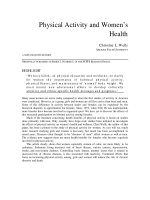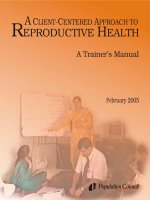Medical Malpractice A Physician’s Sourcebook pptx
Bạn đang xem bản rút gọn của tài liệu. Xem và tải ngay bản đầy đủ của tài liệu tại đây (4.16 MB, 322 trang )
Medical
Malpractice
Medical
Malpractice
A Physician’s
Sourcebook
A Physician’s
Sourcebook
Edited by
Richard E. Anderson,
MD
,
FACP
Edited by
Richard E. Anderson,
MD
,
FACP
M
EDICAL
M
ALPRACTICE
MEDICAL MALPRACTICE
A PHYSICIAN’S SOURCEBOOK
Edited by
RICHARD E. ANDERSON, MD, FACP
Chairman and Chief Executive Officer,
The Doctors Company, Napa, CA
© 2005 Humana Press Inc.
999 Riverview Drive, Suite 208
Totowa, New Jersey 07512
humanapress.com
For additional copies, pricing for bulk purchases, and/or information about other Humana titles,
contact Humana at the above address or at any of the following numbers: Tel.: 973-256-1699;
Fax: 973-256-8341, E-mail: ; or visit our Website: www.humanapress.com
All rights reserved.
No part of this book may be reproduced, stored in a retrieval system, or transmitted in any form or by any means,
electronic, mechanical, photocopying, microfilming, recording, or otherwise without written permission from the
Publisher.
All articles, comments, opinions, conclusions, or recommendations are those of the author(s), and do not necessarily
reflect the views of the publisher.
This book is sold with the understanding that neither the author nor the publisher is engaged in rendering legal advice
or the practice of law. If legal advice is required, it is the responsibility of the reader to hire an attorney. Publisher
and author are not responsible for any errors or omissions or for any consequences from the application of the
information presented in this book pertaining to matters of law.
Due diligence has been taken by the publishers, editors, and authors of this book to assure the accuracy of the
information published and to describe generally accepted practices. The contributors herein have carefully checked
to ensure that the drug selections and dosages set forth in this text are accurate and in accord with the standards
accepted at the time of publication. Notwithstanding, as new research, changes in government regulations, and
knowledge from clinical experience relating to drug therapy and drug reactions constantly occurs, the reader is
advised to check the product information provided by the manufacturer of each drug for any change in dosages or
for additional warnings and contraindications. This is of utmost importance when the recommended drug herein is
a new or infrequently used drug. It is the responsibility of the treating physician to determine dosages and treatment
strategies for individual patients. Further it is the responsibility of the health care provider to ascertain the Food and
Drug Administration status of each drug or device used in their clinical practice. The publisher, editors, and authors
are not responsible for errors or omissions or for any consequences from the application of the information presented
in this book and make no warranty, express or implied, with respect to the contents in this publication.
Production Editor: Robin B. Weisberg
Cover design by Patricia F. Cleary
This publication is printed on acid-free paper. ∞
ANSI Z39.48-1984 (American National Standards Institute) Permanence of Paper for Printed Library Materials.
Photocopy Authorization Policy:
Authorization to photocopy items for internal or personal use, or the internal or personal use of specific clients, is
granted by Humana Press Inc., provided that the base fee of US $25.00 per copy is paid directly to the Copyright
Clearance Center at 222 Rosewood Drive, Danvers, MA 01923. For those organizations that have been granted a
photocopy license from the CCC, a separate system of payment has been arranged and is acceptable to Humana Press
Inc. The fee code for users of the Transactional Reporting Service is: [1-58829-389-0/05 $25.00].
Printed in the United States of America. 10 9 8 7 6 5 4 3 2 1
eISBN 1-59259-845-5
Library of Congress Cataloging-in-Publication Data
Medical malpractice : a physician's sourcebook / edited by Richard E. Anderson.
p. ; cm.
Includes bibliographical references and index.
ISBN 1-58829-389-0 (alk. paper)
1. Physicians Malpractice United States.
[DNLM: 1. Malpractice United States. 2. Insurance, Liability United States. 3. Medicine United States. 4.
Physicians United States. W 44 AA1 M4884 2005] I. Anderson, Richard E.
KF2905.3.M439 2005
344.7304'11 dc22
2004008594
DEDICATION
This book is dedicated to the men and women in the medical
profession who, day and night, care for the sick
and comfort the dying.
PREFACE
vii
Books such as this one are deceptively difficult to create. The general
subject is neither happy, nor easy, nor most anyone’s idea of fun. Mal-
practice litigation, however, has become a central fact of existence in the
practice of medicine today. This tsunami of lawsuits has led to a high
volume of irreconcilable rhetoric and ultimately threatens the stability of
the entire health care system. Our goal has been to provide a source of
reliable information on a subject of importance to all who provide medi-
cal care in the United States.
The book is divided into four sections. Part I gives an overview of
insurance in general and discusses the organization of professional li-
ability insurance companies in particular. Part II focuses on the litigation
process itself with views from the defense and plaintiff bar, and the
physician as both expert and defendant. Part III looks at malpractice
litigation from the viewpoint of the practicing physician. Some of the
chapters are broadly relevant to all doctors—the rise of e-medicine, and
the importance of effective communication, for example. The other chap-
ters are constructed around individual medical specialties, but discuss
issues that are of potential interest to all.
Part IV looks ahead. “The Case for Legal Reform” presents changes
in medical-legal jurisprudence that can be of immediate benefit. The
final two chapters take a broader perspective on aspects of our entire
health care system and its interface with law and public policy.
This book would not have been possible without the encouragement
of Dr. Frank E. Johnson, and the collaboration of Drs. David B. Troxel
and Mark Gorney.
I am indebted to each of the contributors for their effort, wisdom, and
experience.
I owe special gratitude to Susan Baker for reviewing, editing, and
coordinating the many pieces of the manuscript.
Richard E. Anderson, MD, FACP
INTRODUCTION
ix
It is a difficult time to be a physician in the United States. In an era
when life expectancy is increasing, when major progress has been recog-
nized in the prevention and treatment of coronary artery and cerebrovas-
cular disease, when a new generation of biologic therapies is beginning
to reward decades of effort in the battle against cancer, when AIDS has
become treatable and preventive vaccines are entering clinical trials,
when CAT scanning and MRIs have revolutionized our windows into the
human body, when surgeons can utilize noninvasive operative techniques
and robotic surgery is a reality, when science is now unveiling the
genomic abnormalities in a host of human diseases, how can this be?
Although our therapeutic armamentarium has never been greater, the
pressures on the practice of medicine seem to have increased even more.
Physicians talk about “the coming medical apocalypse” (1), ask whether
we are “helpless” (2), or whether “ being a doctor is still fun” (3)?
Scholarly research is undertaken to measure the degree of physician
discontent and dissatisfaction with the practice of medicine (3–8).
Part of the problem lies in the tangle of conflicting messages physi-
cians regularly hear. Although societal measures of health are improv-
ing, the incidence of medical error is said to be unacceptably high (9,10).
Malpractice litigation is said to target “bad” physicians and to be a nec-
essary adjunct to regulatory and professional discipline (11), yet nearly
one in five doctors reports a malpractice claim annually and one-third to
one-half of high-risk specialists face a claim every year. Are they all bad
doctors? Plaintiff attorneys say they carefully screen malpractice claims
before filing, yet 70–80% of these claims are still found to be without
merit (12).
In this book, we look in detail at contemporary medical malpractice
litigation. We review its history, examine medical malpractice insurance
(which has become a virtual necessity to protect physicians and indem-
nify injured patients), discuss specialty-specific issues, and, finally,
explore alternatives to the current system.
Richard E. Anderson, MD, FACP
MEDICAL PRACTICE IN THE NEW MILLENNIUM
Before focusing on these important concerns, let us look into the
context of medical practice at the onset of the new millennium. Washburn
(1) identifies five trends that he argues have brought us to the brink of
a “medical meltdown”:
1. Excessive business and legal complexity in the provision of medical
care.
2. Decreased medical spending without reduced demand for medical ser-
vices.
3. The increasing role of for-profit corporations in changing the tradi-
tional emphasis on patient care into concern for shareholder equity.
4. A growing population of uninsured patients adding to the financial
stresses on physicians and health care institutions.
5. Provider demoralization.
Keeping pace with ever-expanding medical knowledge is a daunting
task, but physicians must practice “under significantly expanded legal
obligations, face stricter standards of professional accountability for
medical negligence, and no longer enjoy exemption from the laws of
competition” (13). Doctors now face criminal penalties for, among other
things, inadequate documentation, elder care deemed unacceptable, or
erroneous emergency room triage (1).
Concern over the rising cost of health care has led to the era of “man-
aged care.” It is difficult to find any constituency that is fully satisfied
with this development. Physicians are alternately depressed and enraged
at the erosion of their authority in offering professional judgments on
behalf of their patients. Doctors across the United States applauded the
American Medical Association effort to impose the same malpractice
jeopardy on managed care organizations that they themselves faced.
This “the enemy of my enemy is my friend” philosophy ultimately foun-
dered with the realization that more litigation was a poor prescription for
America’s health care system. Physicians came to understand that these
lawsuits would not exempt them from their own legal battles, but would
instead add another cause of action to the malpractice allegations they
already faced.
Government has made life more difficult for America’s doctors with
laws that have reduced Medicare spending by hundreds of billions of
dollars without taking action to reduce demand for services. The federal
government pays for approximately 45% of all health care in the United
States (14). Therefore, these actions have significant direct impact, and,
in addition, reset the bar for the rest of the health care marketplace.
x Introduction
The rise of for-profit corporate medicine offered promise of
numerous important advantages:
1. Funds for infrastructure investment, including the information technol-
ogy in which health care lags far behind other industries.
2. The potential to offer more consistent outcomes and systematic quality
assurance.
3. Scale to allow development of appropriate institutional and provider
specialization.
4. Institutional personnel who could free physicians from activities not
directly related to patient care.
5. The rationalization of a fragmented industry that would produce
enhanced quality at lower cost.
Instead, most cost savings have come from simply reducing payments
to providers. Quality has proven difficult to define and even harder to
measure. Profit imperatives have led to greater selectivity in choosing
which patients to service, rather than commitment to better processes for
improved outcomes. Physicians have found it difficult to align their
incentives with those of their employers, and employers have found it
equally difficult to manage doctors.
Patients, nominally the designated beneficiaries of these changes,
seem the unhappiest of all. They have lost the unquestioned assurance
that the physician is their advocate. Shifts in the marketplace may force
them to find new doctors without warning or cause. Medical costs are
again rising rapidly, and patients are being asked to pay an increasing
share of their own medical bills (15). Only 44% of Americans express
“a great deal of confidence” in medicine (16). (It is of interest, although
not reassuring, that only 12% have a similar degree of confidence in
those who run law firms, and 15% in Congress).
More than 45 million Americans do not have health insurance, but
physicians must provide care to all under legally and ethically defined
circumstances. For the remainder of the population, a panoply of public
and private health plans, not to mention laws and guidelines, regulate the
provision of health care.
THE INCREASING IMPACT OF LAW AND REGULATION
ON MEDICAL PRACTICE
The legal context of medical practice has changed significantly in
recent years. The position of physicians within the US legal system is
“neither as lofty nor as protected as it was previously” (13). There are
Introduction xi
new legal obligations, stricter liability laws, and increased competition.
“Physicians are expected not to discriminate on the basis of race,
national origin, or disability in the selection of patients or the provision
of medical care; to participate in emergency care when part of corporate
hospital enterprises; to conform their practices to a nationally based
professional standard of care; to price their services competitively; and
to not use illegal tactics to eliminate the competition” (13).
The definition of standard of care has evolved from the practices of
competent physicians in the community (the locality rule) to national
standards as articulated in the medical literature and practiced anywhere
in the country.
Contemporary concepts of informed consent are only 30 years old and
are now based on fundamental principles of patient autonomy rather
than physician judgment. Although health care as a right or a privilege
may still be debated, our laws have increasingly defined the terms of
access and the parameters of care.
Increasingly, legal standards of care of have replaced medical stan-
dards. In some cases this may be relatively explicit, such as indications
for Cesarean section based more on the probability of liability than medi-
cal judgment. Frequently, however, the replacement of medical judg-
ment by courtroom standards is more subtle. Examples are as varied as
the high rate of “false-positive” readings on mammography and the high
incidence of antibiotic prescription to prevent even the remotest possi-
bility of Lyme disease (17).
In either case, the outcome is similar, an increase in the practice of
defensive medicine. This is unfortunate for two reasons. First, it adds to
the cost of care and thereby reduces access (18). Second, defensive medi-
cine, by definition, is unnecessary. It undermines both the doctor–patient
relationship and physician belief in the value of medical judgment.
THE PROFESSION OF MEDICINE
Therefore, it is not surprising that physician “angst” is high. Washburn
says it plainly enough: “Ask any clinician: it is getting harder and harder
to enjoy practicing medicine” (1). More than one-third of doctors say
they would probably not choose to enter medical school again (3).
Although 84% of women physicians express satisfaction with their ca-
reer, 31% say they might not choose to be a physician again (7). This is
especially notable because of the rising percentage of America’s doctors
who are women. By 2010, the figure is projected to be 30% (7).
The primary cause for this dissatisfaction is not declining income, but
decreased autonomy and the sense that medical practice is no longer the
xii Introduction
calling it once was (2,3,5,7). There is a major groundswell of comment
on the nature of physician-hood, and the meaning of “profession” (19–
22). This admirable discourse illustrates the nature of the pressures
impacting the practice of medicine. In the face of “perverse financial
incentives, fierce market competition, and the erosion of patients’ trust”
(19) physicians are asked to re-emphasize their commitment to the pro-
fession of medicine. The three core elements of professionalism are
defined as follow (19):
1. Moral commitment to the ethic of medical service.
2. Public profession of values.
3. The negotiation of “social priorities that balance medical values with
other social values.”
This process will result in a new social contract between physicians
and society.
The authors of the proposed Charter on Medical Professionalism (23)
also see professionalism as the core of the social contract for medicine and
are concerned that the pressures of contemporary medical practice are
“tempting physicians to abandon their commitment to the primacy of
patient welfare.” They identify the following three fundamental principles:
1. Principle of primacy of patient welfare.
2. Principle of patient autonomy.
3. Principle of social justice.
The latter requires physician advocacy beyond the welfare of indi-
vidual patients to “promote justice in the health care system” (23).
Ten professional responsibilities are also cited:
1. Commitment to professional competence.
2. Commitment to honesty with patients, emphasizing both informed con-
sent, and prompt reporting and analysis of medical error.
3. Commitment to patient confidentiality.
4. Commitment to maintaining appropriate relations with patients such as
the avoidance of patient exploitation for sexual advantage, financial
gain, or other private purpose.
5. Commitment to improving quality of care.
6. Commitment to improving access to care.
7. Commitment to just distribution of finite resources.
8. Commitment to scientific knowledge.
9. Commitment to maintain trust by managing conflicts of interest.
10. Commitment to professional responsibilities emphasizing the indi-
vidual and collective obligations to participate in processes to improve
patient care (23).
Introduction xiii
In today’s medical-legal world, there are no guarantees against
unwarranted litigation, and no certain protection against continuing
erosion of the doctor–patient relationship. Nonetheless, every constitu-
ency in our society agrees on the critical nature of medical services and
all want more, not less, access. Ultimately, the practice of medicine is too
important, and the men and women who undertake it too estimable, for
the system not to balance itself.
This book is offered as a look at the problems, some solutions that are
available today, and more that are possible in the future.
REFERENCES
1. Washburn ER. The coming medical apocalypse. The Physician Executive, 1999:34–
38.
2. Davidson C. Are we physicians helpless. N Engl J Med 1984; 310:1116–1118.
3. Chuck J, Nesbitt T, Kwan J, Kam S. Is being a doctor still fun? West J Med 1993;
159:665–669.
4. Murray A, Montgomery J, Chang H, Rogers W, Inui T, Safran D. Doctor discon-
tent—a comparison of physician satisfaction in different delivery system settings,
1986 and 1997. J Gen Intern Med 2001; 16:451–459.
5. Landon B, Reschovsky J, Blumenthal D. Changes in career satisfaction among
primary care and specialist physicians, 1997–2001. JAMA 2003; 289:442–449.
6. Sullivan P, Buske L. Results from CMA’s huge 1998 physician survey point to a
dispirited profession. CMAJ 1998; 159:525–528.
7. Frank E, McMurray J, Linzer M, Elon L. Career satisfaction of US women physi-
cians. Arch Intern Med 1999; 159:1417–1426.
8. Schulz R, Scheckler W, Moberg D, Johnson P. Changing nature of physician satis-
faction with health maintenance organization and fee-for-service practices. J Fam
Practice 1997; 45:321–330.
9. Kohn LT, Corrigan JM, Donaldson MS. To Err Is Human: Building a Safer Health
Care System. Washington, DC: Institute of Medicine, 1999.
10. Weiler PC, Hiatt HH, Newhouse JP, Johnson WG, Brennan TA, Leape LL. A
Measure of Malpractice. Cambridge, MA: Harvard University Press, 1993.
11. Nace BJ, Stewart LS. Straight talk on medical malpractice. American Trial Lawyers
Association, 1994:20.
12. Harming Patient Access to Care: Implications of Excessive Litigation. Subcommit-
tee on Health, Committee on Energy and Commerce, US House of Representatives.
Washington, DC: U.S. Government Printing Office, 2002:160.
13. Rosenbaum S. The impact of United States law on medicine as a profession. JAMA
2003; 289:1546–1556.
14. Levit K, Smith C, Cowan C, Sensenig A, Catlin A, Team HA. Health spending
rebound continues in 2002. Health Affairs 2004; 23:147–159.
15. Herper M. GE Strike Sounds Health Care Alarm. Forbes.com. Vol. http://
www.forbes.com/home/2003/01/14/cx_mh_0114ge.html, 2003.
16. Taylor H. The Harris Poll #6, Confidence in leadership of nation’s institutions
remains relatively high: www.harrisinteractive.com/harris_poll/index.asp?PID=3,
2000.
xiv Introduction
17. Anderson R. Billions for defense: the pervasive nature of defensive medicine. Arch
Intern Med 1999; 159:2399–2402.
18. U.S. Department of Health and Human Services. Confronting the New Health Care
Crisis: Improving Health Care Quality and Lowering Costs by Fixing Our Medical
Liability System. Washington, DC, 2002:1–28.
19. Wynia M, Latham S, Kao A, Berg J, Emanuel L. Medical professionalism in society.
N Engl J Med 1999; 341:1612–1616.
20. Brennan T. Physicians’ professional responsibility to improve the quality of care.
Acad Med 2002; 77:973–980.
21. Swick H. Toward a normative definition of medical professionalism. Acad Med
2000; 75:612–616.
22. Meakins J. Medical professionalism in the new millenium. J Am Coll Surg
2003:113–114.
23. Brennan T, Blank L, Cohen J, et al. Medical professionalism in the new millennium:
a physician charter. Ann Int Med 2002; 136:243–246.
Introduction xv
xvii
CONTENTS
Preface vii
Introduction ix
Contributors xix
PART I. INSURANCE
1 Insuring the Practice of Medicine 3
Mark Gorney and Richard E. Anderson
PART II. LEGAL
2 What Every Doctor Should Know About Litigation:
A Primer on How to Win Medical Malpractice
Lawsuits 11
Fred J. Hiestand
3 Risk Reduction From a Plaintiff Attorney’s
Perspective 35
David Wm. Horan
4 The Physician As a Witness 41
Joel A. Mattison
5 The Judicial Process: Discovery and Deposition 53
Jonathan I. Epstein
PART III. THE CLINICAL FACE OF LITIGATION
6 Communication and Patient Safety 65
Mark Gorney
7 E-Medicine in the Physician’s Office 75
Edward Fotsch
8 Risk Management for the Family Physician 89
Malcolm H. Weiss
9 Emergency Medicine 101
Michael Jay Bresler
xviii Contents
10 Anesthesiology 115
Ann S. Lofsky
11 Malpractice and Medical Practice: Obstetrics
and Gynecology 139
Jack M. Schneider
12 Breast Cancer Litigation 153
Richard E. Anderson and David B. Troxel
13 Pap Smear Litigation 167
David B. Troxel
14 Medical Liability in Plastic and Reconstructive
Surgery 181
Mark Gorney
PART IV. LEGAL REFORM AND HEALTH CARE
15 The Case for Legal Reform 201
Richard E. Anderson
16 Health Policy Review: Medical Malpractice 227
David M. Studdert, Michelle M. Mello,
and Troyen A. Brennan
17 New Directions in Medical Liability Reform 247
William M. Sage
Index 279
CONTRIBUTORS
RICHARD E. ANDERSON, MD, FACP • Chairman and Chief Executive
Officer, The Doctors Company, Napa, CA; former Chief
of Medicine, Scripps Memorial Hospital, LaJolla CA, and former
Clinical Professor of Medicine, University of California, San
Diego, CA
T
ROYEN A. BRENNAN, MD, JD, MPH • Department of Health Policy
and Management, Harvard School of Public Health, Brigham
and Women’s Hospital, Boston, MA
M
ICHAEL JAY BRESLER, MD, FACEP • Clinical Professor, Division
of Emergency Medicine, Stanford University School of Medicine,
Stanford, CA; Medical Director, Department of Emergency
Medicine, Mills-Peninsula Health System, Burlingame, CA
J
ONATHAN I. EPSTEIN, MD • Professor, Departments of Pathology,
Urology, and Oncology; the Reinhard Professor of Urologic
Pathology; and Director of Surgical Pathology, Johns Hopkins
Medical Institutions, Baltimore, MD
E
DWARD FOTSCH, MD • Medem Inc., San Francisco, CA
M
ARK GORNEY, MD • Founding Member, Board of Governors,
and Medical Director, The Doctors Company, Napa, CA;
Professor (em), Plastic and Reconstructive Surgery, Stanford
University, Stanford, CA
F
RED J. HIESTAND, JD • Counselor at Law; General Counsel
to the Civil Justice Association of California (1978–Present);
CEO and General Counsel to Californians Allied
for Patient Protection, Sacramento, CA
D
AVID WM. HORAN, MD, JD • Trial lawyer, St. Louis, MO and Chicago,
IL; Member of Trial Team, Miles vs. Philip Morris, US
A
NN S. LOFSKY, MD • Anesthesiologist, Saint John’s Hospital, Santa
Monica, CA; Member, Board of Governors, The Doctors
Company, Napa, CA
J
OEL A. MATTISON, MD, FACS • Department of Utilization Management
and Quality Assurance, St. Joseph’s Hospital, Tampa, FL; former
Clinical Professor of Surgery, University of South Florida, Tampa,
FL
xix
MICHELLE M. MELLO, JD, PhD, MPhil • Assistant Professor of Health
Policy and Law, Department of Health Policy and Management,
Harvard School of Public Health, Boston, MA
W
ILLIAM M. SAGE, MD, JD • Professor of Law, Columbia Law School,
New York, NY
J
ACK
M. S
CHNEIDER
,
MD
• Chief Medical Officer, Sharp Mary Birch
Hospital for Women, San Diego, CA
DAVID M. STUDDERT, LLB, ScD, MPH • Department of Health Policy
and Management, Harvard School of Public Health, Boston, MA
D
AVID B. TROXEL, MD, FCAP • Member, Board of Governors, The
Doctors Company, Napa, CA; Clinical Professor, Health and
Medical Sciences, University of California, Berkeley, CA
M
ALCOLM H.WEISS, MD • Clinical Professor, Department of Family
and Community Medicine, University of Nevada School of
Medicine, Reno, NV
xx Contributors
Chapter 1 / Insuring the Practice of Medicine 1
I
INSURANCE
2 Gorney and Anderson
Chapter 1 / Insuring the Practice of Medicine 3
From: Medical Malpractice: A Physician’s Sourcebook
Edited by: R. E. Anderson © Humana Press Inc., Totowa, NJ
3
SUMMARY
Although all physicians are aware that practicing medicine in the
United States is virtually impossible without some form of liabil-
ity insurance, many have only a limited understanding of how the
American system of professional assurance really works. It is
important for the practicing physician to understand not only some
of the technical language regarding insurance but also the various
forms in which it is available. Doctors should understand the dis-
tinguishing features of an effective insurance program.
Key Words: Spread of risk; underwriting; claims made; occur-
rence; surplus.
INTRODUCTION
Virtually all practicing physicians in the United States require medi-
cal malpractice insurance. Although malpractice insurance is legally
required in only a few states, the vast majority of hospitals and other
health care institutions mandate that all medical staff members be
insured. Specialty insurance companies that provide only professional
liability insurance and multiline companies that cover this type of risk
and many others provide this coverage.
1
Insuring the Practice of Medicine
Mark Gorney, MD
and Richard E. Anderson, MD, FACP
4 Gorney and Anderson
About two-thirds of America’s doctors are insured by mutual or
reciprocal companies. These are owned by the physician policyhold-
ers and are not responsible to outside shareholders. Virtually all of
these companies specialize in professional liability insurance with
limited or no exposure to other lines of business. The remaining one-
third of doctors are insured by publicly traded commercial carriers
owned by shareholders rather than policyholders. Most, but not all, of
these companies sell multiple lines of insurance and tend to move in
and out of malpractice coverage as business conditions warrant.
The fundamental business principles that apply to all American
businesses also apply to insurance companies: income must cover
expenses. For insurance companies, the major categories of expenses
are as follows:
1. Losses represent the payments made to plaintiffs as a result of jury
verdicts or settlements.
2. Legal defense represents the legal costs associated with settling or
litigating individual claims; these are primarily defense attorney and
expert witness fees.
3. Operating expenses include all other expenses incurred by the insur-
ance company. Such expenses include underwriting, claims adminis-
tration, finance, computer systems, marketing, and agent commissions.
However, there are a number of areas in which insurance differs
from other businesses. The most important area is the need to collect
an appropriate amount of premium today to cover the cost of losses
and legal defense that may, and often do, occur 4 to 6 years in the
future. By definition, actual future costs are unknown at the time the
insurer must price and sell the policy. If insurers seriously underesti-
mate future costs and fall into insolvency, the physician is left without
the liability protection that he or she paid for, but the liability remains.
Therefore, the choice of a malpractice insurance company is an impor-
tant one for physicians. The true value of a policy (as opposed to its
cost) may not be apparent until years after the purchase, when a claim
must be defended and possibly paid.
The following principles of insurance and definitions of key terms
are intended to facilitate that choice.
SPREAD OF RISK
Physicians as a group, knowing some of them will be sued and will
have to pay litigation costs and losses, pool resources to share the total
burden of the group. In any given year, not every physician will be sued,









